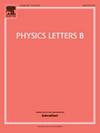超核诱导反应中通过其v2流探测Λ电位
IF 4.5
2区 物理与天体物理
Q1 ASTRONOMY & ASTROPHYSICS
引用次数: 0
摘要
超子势,特别是它在高密度下的行为,对于解决中子星中的“超子谜题”和推进我们对高重子密度环境中奇怪和非奇怪粒子之间强相互作用的理解至关重要。利用强子输运模型AMPT-HC,研究了超核-核碰撞。研究发现,当束流能量低于产生超子的阈值时,超子椭圆流在正、负快区之间表现出明显的不对称性,并且对超子势的强度敏感,特别是在大的负快区。在负快速区基于椭圆流的超子势可以提取出大约两倍于饱和密度的超子势,在正快速区基于椭圆流的超子势可以提取出饱和密度附近的超子势。本文章由计算机程序翻译,如有差异,请以英文原文为准。
Probing Λ potential via its v2 flow in hypernuclei-induced reaction
The hyperon potential, particularly its behavior at high densities, is crucial for resolving the “hyperon puzzle” in neutron stars and for advancing our understanding of the strong interactions between strange and non-strange particles in high baryon density environments. Using the hadronic transport model AMPT-HC, hypernucleus-nucleus collision is studied. It is found that at beam energies below the threshold for hyperon production, the hyperon elliptic flow exhibits noticeable asymmetry between the positive and negative rapidity regions and is sensitive to the strength of the hyperon potential, especially in the large negative rapidity region. One can extract the hyperon potential approximately twice the saturation density based on the hyperon elliptic flow in the negative rapidity region, and the hyperon potential around the saturation density based on the hyperon elliptic flow in the positive rapidity region.
求助全文
通过发布文献求助,成功后即可免费获取论文全文。
去求助
来源期刊

Physics Letters B
物理-物理:综合
CiteScore
9.10
自引率
6.80%
发文量
647
审稿时长
3 months
期刊介绍:
Physics Letters B ensures the rapid publication of important new results in particle physics, nuclear physics and cosmology. Specialized editors are responsible for contributions in experimental nuclear physics, theoretical nuclear physics, experimental high-energy physics, theoretical high-energy physics, and astrophysics.
 求助内容:
求助内容: 应助结果提醒方式:
应助结果提醒方式:


